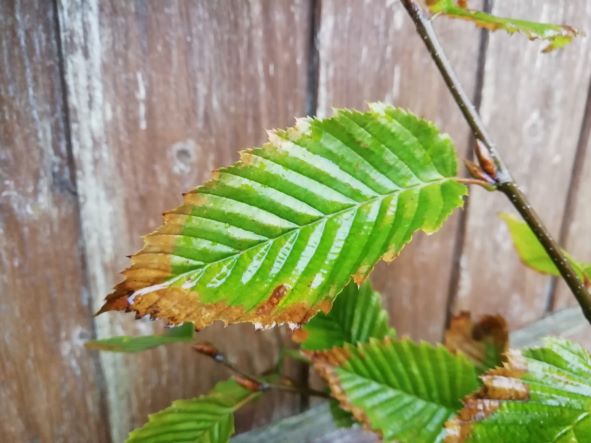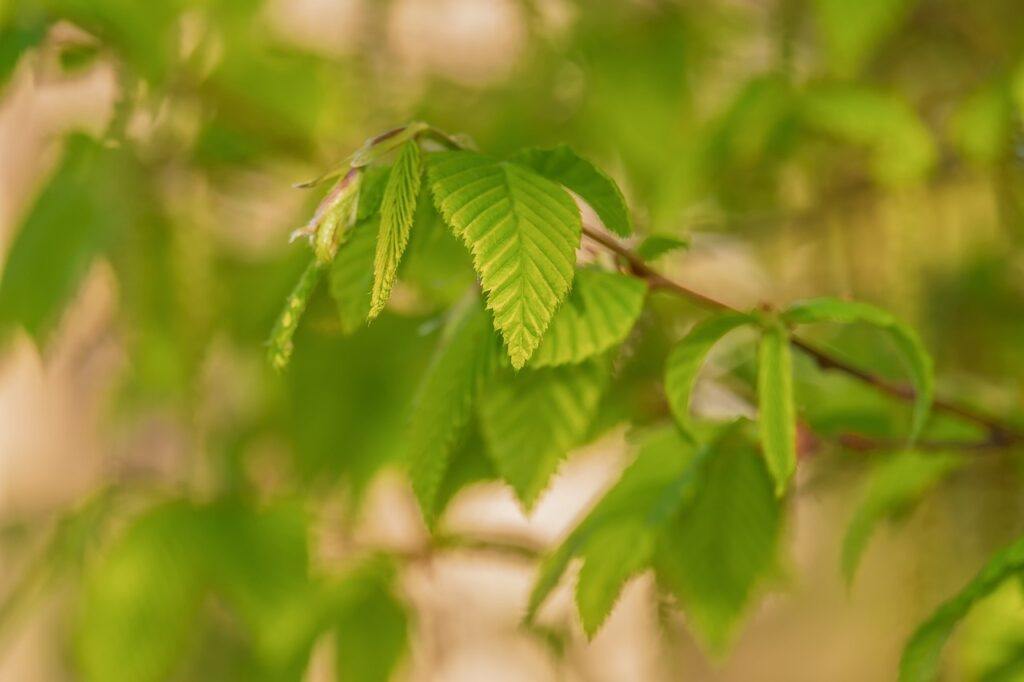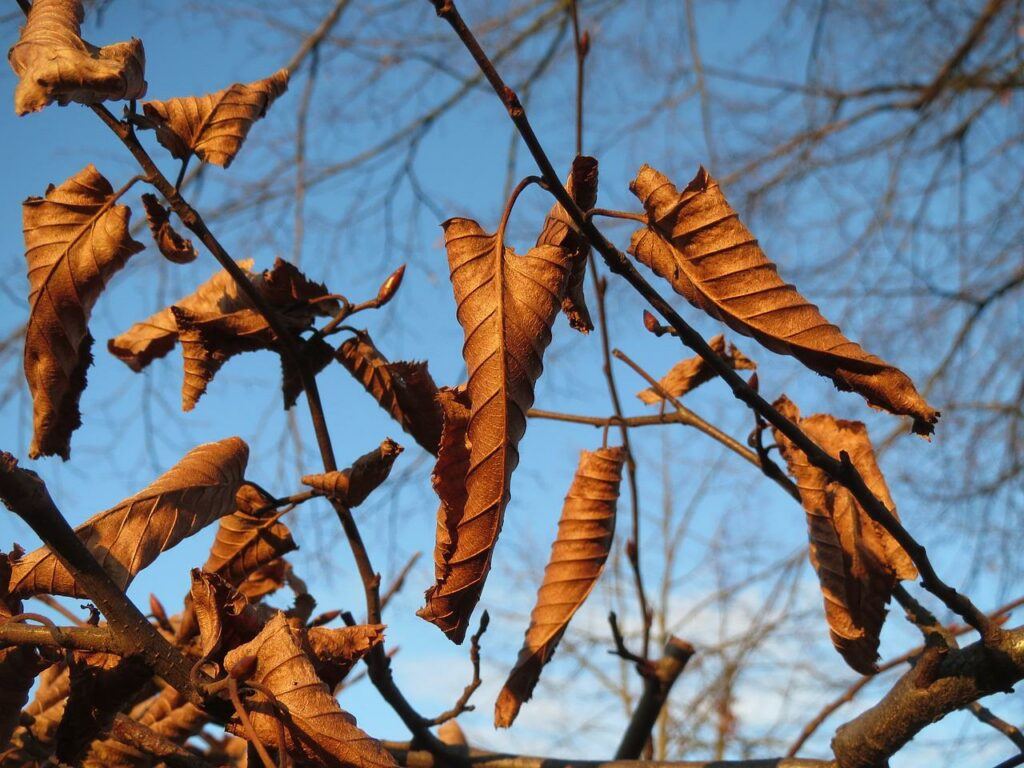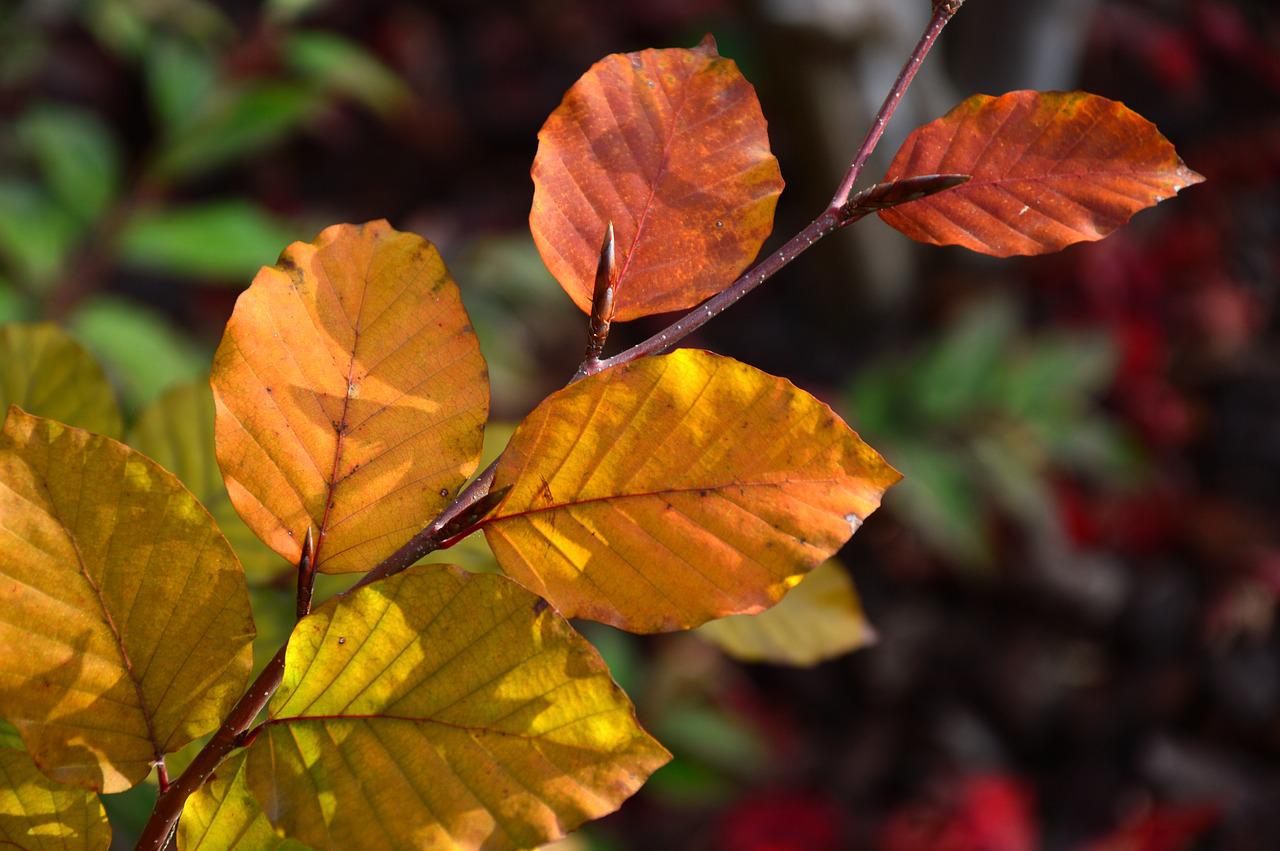The Hornbeam is a beautiful deciduous hardwood tree.
It has very ridged and serrated leaves that are bright green in spring and summer, turning yellow, orange and red through the autumn and into winter.
Hornbeams are fairly hardy and resilient but can be susceptible to some infections and problems.
So if you have asked the question “Why Is My Hornbeam Hedge Dying?” then read on for answers and solutions.
2. Armillaria Root Rot (Honey Fungus)
3. Phytophthora Root Rot
4. Heart Rot
5. Canker Disease – Hypoxylon Canker
6. European Fruit Lecanium “Apricot Scale”
Lack of Water
If your Hornbeam has green wilted leaves that look soft, thin and papery, or is prematurely turning brown and dropping it’s leaves, these could be signs of dehydration.
This is a stress reaction and the tree’s attempt to reduce further loss of water.
Another sign can be Leaf Scorch, where the leaves dry out and turn brown and crispy from the outside in.
Hornbeams prefer slightly wet and moisture retentive soils.
This is especially true when they are young.
As they age and grow they become more drought resistant.
How to fix:
- If you are planting a new Hornbeam sapling then add some compost to the soil to aid moisture retention.
- Water in well and continue to irrigate every few days until the plant becomes established and you start to see new growth.
- If the weather is dry with little natural rain, then continue to provide water during these times for the first year.
- Consider adding a mulch around the base in spring and again in early winter to protect and nourish.
- After the first year the tree should be established enough to find it’s own water however should there be a particularly dry period, or if you have very poor soil, or if you see the signs above, then continue to provide extra water.

Armillaria Root Rot (Honey Fungus)
This is a fungus that can attack woody shrubs and trees, and we have seen from previous posts that it can also affect Privets and Rowan trees.
It spreads through the soil creating black root like fungal structures called rhizomorphs
These are known as “bootlaces”.
The fungus shows mainly at the base of the trunk and can be seen as a white layer between the bark and the internal stem.
The bark then starts to crack and rot.
There will likely be a strong mushroomy odour and possibly an abundance of honey coloured mushrooms around the base.
The fungus attacks the roots and the trunk which eventually causes widespread decline.
Honey fungus tends to attack plants that are already stressed or unwell.
How to fix:
- Unfortunately there is no cure for Honey Fungus so plants that have been infected should be totally removed including as much of the root system and soil as possible and disposed of (not in the compost heap).
- The surrounding soil should be turned over to break down the rhizomorphs.
- You can bury plastic pond liner around infected areas to stop rhizomorph growth.
- It is better to prevent infection through good garden hygiene which will help general tree health and natural resilience.
- Maintain good airflow around the base of your plants.
Phytophthora Root Rot
Another type of fungus that attacks the root system from underground, although airborne spores are possible too.
It usually occurs in extremely wet and saturated soils.
Although Hornbeams prefer a moist soil, like most plants they do not like to sit in waterlogged ground.
Symptoms present as the plant starts to struggle with a failing root system.
The roots become rotten and turn black or brown. Foliage becomes weak, wilted and discoloured.
Full branches can start to deteriorate.
How to fix:
- If you catch Phytophthora Root Rot early enough and the Hornbeam is small enough to uproot, then it is possible to treat.
- The Hornbeam should be taken up quickly and the roots washed with clean water.
- Any decaying material and surrounding soil should be removed and disposed of (not in the compost heap).
- Sterilise any tools or pots used.
- Replant in a different area with drier soils and better drainage. Monitor to make sure it recovers.
- Prevention is better than a cure so do not overwater the garden or susceptible plants.
- Sometimes water can run off and collect in a particular area causing it to become saturated.
- If this happens you can work in some grit or stones to improve drainage and adjust the planting to varieties that like wet ground such as bog plants.

Heart Rot
This fungal infection attacks the centre of the trunk and other limbs of the Hornbeam tree.
Because the effects are internal, it can sometimes be difficult to spot.
The fungus eats away at the centre causing the wood to soften, and eventually cavities are formed.
This weakens the wood and makes the tree more likely to break and split in stormy weather.
How to fix:
- Promote the general health of the tree by providing adequate water
- Clear debris from around the base of the tree to promote airflow.
- Remove any branches that are rubbing on each other as this can cause an open wound that could allow infection to enter.
- Clear any dead branches to keep the canopy ventilated.
- Try to avoid cuts or damage to the bark.
- If Heart Rot does take hold there is no real cure and as it can cause affected trees to become unstable, for safety reasons it will probably best to remove the tree.
- Make sure to contact a professional tree surgeon to assist you with this and dispose of any infected material (not on the compost heap).
Canker Disease – Hypoxylon Canker
This fungal infection can affect many hardwood trees like Hornbeam, Oak and Aspen.
The spores are airborne and if they find a tree with a wound or hole in the bark, they can enter and infect that tree.
It takes the form of dark or discoloured patches of dead bark tissue with orange or brown edging.
These patches can be raised or sunken, and in some cases extend to circle the branch.
When this happens the whole branch can die back.
If you can catch it before the disease has spread to the trunk, it is possible to save the tree.
How to fix:
- There is no fungal treatment or cure unfortunately.
- Do your best to prevent the conditions necessary for the fungus to grow.
- Avoid damaging tree bark wherever possible.
- Prune branches that are rubbing on each other as this can cause a sore.
- Clear debris and dead material from the canopy and around the base to aid ventilation.
- If you see the signs then act quickly and cut out infected branches at least 30cm down from the canker.
- Cut the wood cleanly using sterilised and sharp tools.
- Sterilise all tools and hands afterwards.
- Dispose of all affected wood (not on the compost heap).
- If the disease has infected the trunk you will likely have to remove the tree.

European Fruit Lecanium “Apricot Scale”
These are insects that live and feed on woody shade trees.
They look like miniature brown turtle or limpet shells in their adult form, which can be seen grouped together on branches and twigs.
The young are smaller and pale pink, they usually group on the underside of twigs and leaves.
Signs to look out for are sticky leaves and/or sooty mould.
This is formed by the insect’s honeydew excrement, which then grows fungus.
If left untreated they can become quite damaging to the plant and stunt the growth.
How to fix:
- It is easier to treat when the insects are young so do not delay
- If you notice an infestation it is best to contact a professional, as they will have access to appropriate chemical control.
- If you cannot source a professional then Neem oil is an option, with repeat sprays before dawn and dusk, for 10 days.
- Remove affected branches and dispose (not in the compost heap).
Final Thoughts
Hornbeam trees are one of my absolute favourites.
The colour they provide all through the year is stunning.
Left to grow, Hornbeams can become medium-sized trees however many people use them as hedges.
The leaves tend not to fall in the winter despite changing to a golden brown.
This maintains the hedge structure while providing pleasing colour and refuge for wildlife.
Despite being a hardwood however, they can be affected by occasional problems.
Insects and fungi will usually attack a plant that is damaged or devitalised in some way so it is best to promote your Hornbeam’s natural defences by maintaining a strong and healthy plant.
Hopefully the information above will help you identify and resolve any issues your Hornbeam tree, hedge or plant may be having.
If you come across something not covered, please do drop me a message and I will do my best to help.


Hi there, four years ago, I planted three small hornbeam saplings as a mini-hedge. I’ve just pruned them back a bit and have noticed, that one of them seems to be half alive and half dead. Why is this happening, I wonder? Sometimes, when we get a lot of rain, the water collects around the saplings, but eventually drains away. Could this be an issue? Would really appreciate your help. Thanks.
Dear Carola,
Thanks for your query. Young Hornbeams do not mind moist or heavy soil as long as the drainage is good and it drains away fairly quickly. What sort of soil do you have? If it is heavy or clay, then while this type of soil is fine for Hornbeams in general, the water may be pooling for too long and causing problems for the roots. Is the affected sapling planted in a dip or lower than the others? If you can, gently dig under the affected tree and see if you can examine any of the root system. If it seems like it is decomposing then that will be the issue. If you can’t examine the roots – ie difficult to get to or it will cause too much disturbance, try minimising the amount of pooling water. You can do this by redirecting the water flow with channels dug into the soil. Perhaps work in some sand or grit to the surrounding soil to encourage better drainage away from the trees.
Hope this helps,
All the best,
Sue